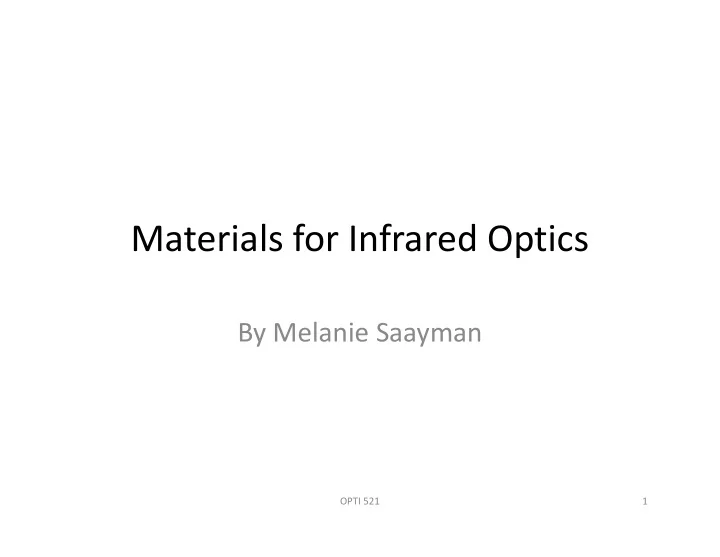

Materials for Infrared Optics By Melanie Saayman OPTI 521 1
Overview • Transmittance of IR glasses • Comparison IR vs. Visible glasses • Properties of some common IR glasses – Germanium – Silicon Silicon – Zinc Sulfide – Zinc Selenide – Magnesium Fluoride – Sapphire • Concerns using lens design programs • List of Suppliers • References OPTI 521 2
Atmospheric Transmittance OPTI 521 3
Transmittance of IR glasses OPTI 521 4
Comparison: IR vs. Visible Glasses • There are much fewer IR glasses than visible glasses. • Refractive indices for IR glasses much higher. – Visible: n = 1.45 - 2.0 Visible: n = 1.45 - 2.0 – IR: n = 1.38 - 4.0 • Dispersion is often much lower for IR glasses. – Visible: ν = 20 - 80 – IR: ν = 20 – 1000 OPTI 521 5
Comparison: IR vs. Visible Glasses • Many IR glasses are opaque in the visible. • Most visible glasses are opaque in the IR. • IR glasses are often heavier than visible glasses. glasses. • IR glasses have significantly higher dn/dT values (x10 or more) - athermalizing difficult. • IR glasses are more expensive than visible glasses (x2 or more). OPTI 521 6
Germanium • Most common IR material • LWIR and MWIR • High refractive index: n = 4.0243 • Large dn/dT (396 ppm/K) can cause large Large dn/dT (396 ppm/K) can cause large focus shift as a function of temperature. • Expensive OPTI 521 7
Silicon • Large dn/dT – 150 ppm/K • Primarily 3 – 5 MWIR • Large n = 3.4255 • Relatively low dispersion Relatively low dispersion • Can be diamond turned (with difficulty) OPTI 521 8
Zinc Sulfide • Common material • LWIR and MWIR • Cleartran in the most common commercially available zinc sulfide available zinc sulfide
Zinc Selenide • Similar to zinc sulfide but structurally weaker • Expensive • Very low absorption coefficient • Transmits in the IR and visible Transmits in the IR and visible Magnesium Fluoride • Low cost • Transmits from UV to MWIR spectral band • Poor thermal properties OPTI 521 10
Sapphire • Extremely hard. – Difficult, time consuming and expensive to manufacture. • Transmits deep UV through MWIR. • Transmits deep UV through MWIR. • Very low thermal emissivity at high temperature. • Cannot be diamond turned. • n = 1.6753, dn/dT = 10 ppm/K OPTI 521 11
Summary of IR Material Properties Material Refractive�Index CTE (ppm/K) dn/dT�(ppm/K) Knoop� Spectral� Hardness� Range @�4 µ m @�10 µ m (g/mm 2 ) Germanium 4.0243 4.0032 6 396 800 2.0�– 17.0� µ m Silicon 3.4255 N/A 2.7 150 1150 1.2�– 9.0� µ m ZnS� 2.2523 2.2008 4.6 54 230 0.37�– 14.0� µ m (Cleartran) (Cleartran) ZnSe 2.4331 2.4065 7.1 60 105 0.55�– 20.0� µ m Magnesium� 1.3526 N/A 8 20 415 0.11�– 7.5� µ m Fluoride Sapphire 1.6753 N/A 5.6 13.7 1370 0.17�– 5.5� µ m Gallium� 3.3069 3.2778 5.7 148 721 0.9�– 16.0� µ m Arsenide CaF 2 1.4097 1.3002 18.9 -11 170 0.13�– 10.0� µ m BaF 2 1.458 1.4014 18.4 -15 82 0.15�– 12.5� µ m OPTI 521 12
Concerns using Lens Design Programs • Most lens design programs use some literature source of data for IR materials, then fit the data to Sellmeier equations. • Sometimes this data is inconsistent, coming from different measurement sources, and may not different measurement sources, and may not have sufficient significant digits. • Thermal data, such as CTE and dn/dT, may vary widely for some materials, depending on who measured it. • Often, the software does not include this data, as there is no official source. OPTI 521 13
Suppliers • Elcan Optical Systems, Richardson, TX • Corning NetOptix, Keene, NH • Exotic Electro-Optics, Marietta, CA • Optimum Optical Systems, Camarillo, CA • II-VI Incorporated, Saxonburg, PA • II-VI Incorporated, Saxonburg, PA • Janos Technology, Keene, NH • DRS Optronics, Palm Bay, FL • Coherent, Auburn, CA • Diversified Optical Products, Salem, NH • Telic OSTI, North Billerica, MA OPTI 521 14
References • R. E. Fisher et al., Optical System Design, 2 nd ed. (McGraw-Hill, 2008) • Max Riedl, Optical Design Fundamentals for Infrared Systems (SPIE Press, 2001) • Richard C. Juergens, Infrared Optical Systems, • Richard C. Juergens, Infrared Optical Systems, Practical Optics Seminar (2006) • Wolfe and Zissis, The Infrared Handbook, Office of Naval Research (1978) • Paul Klocek and Marcel Dekker, Handbook of Infrared Optical Materials (1991) OPTI 521 15
Recommend
More recommend